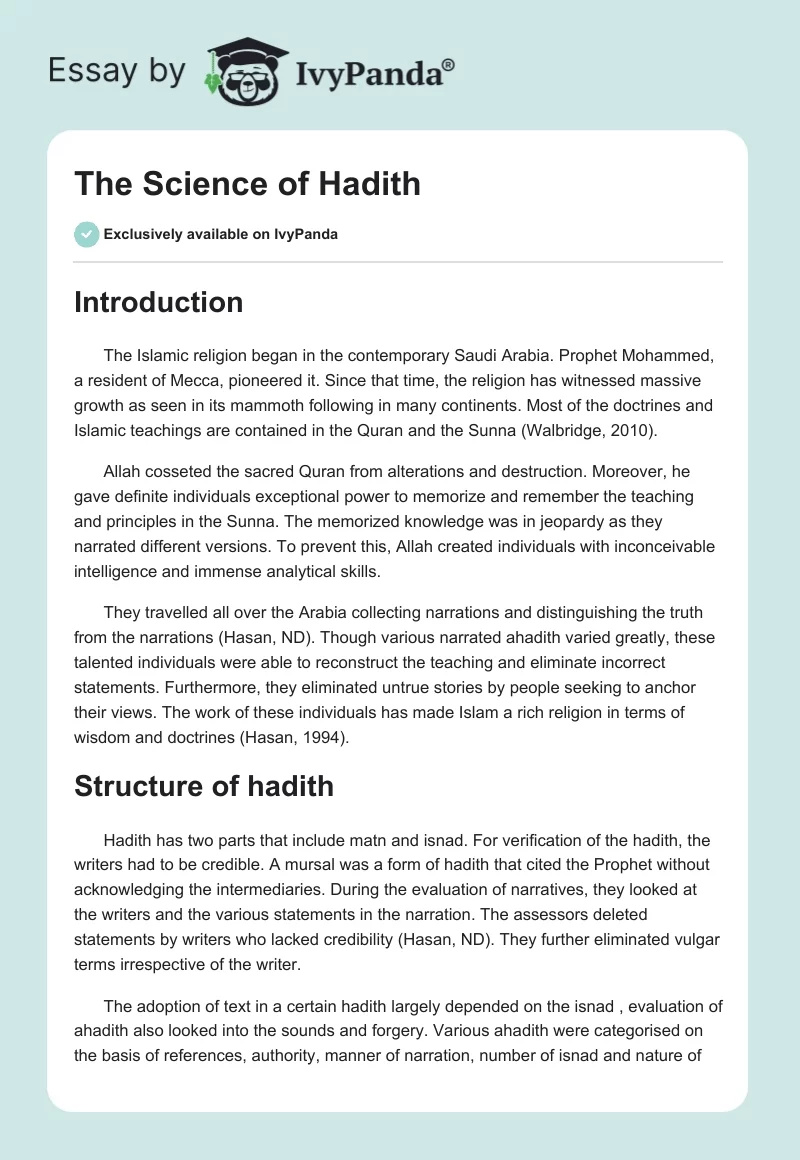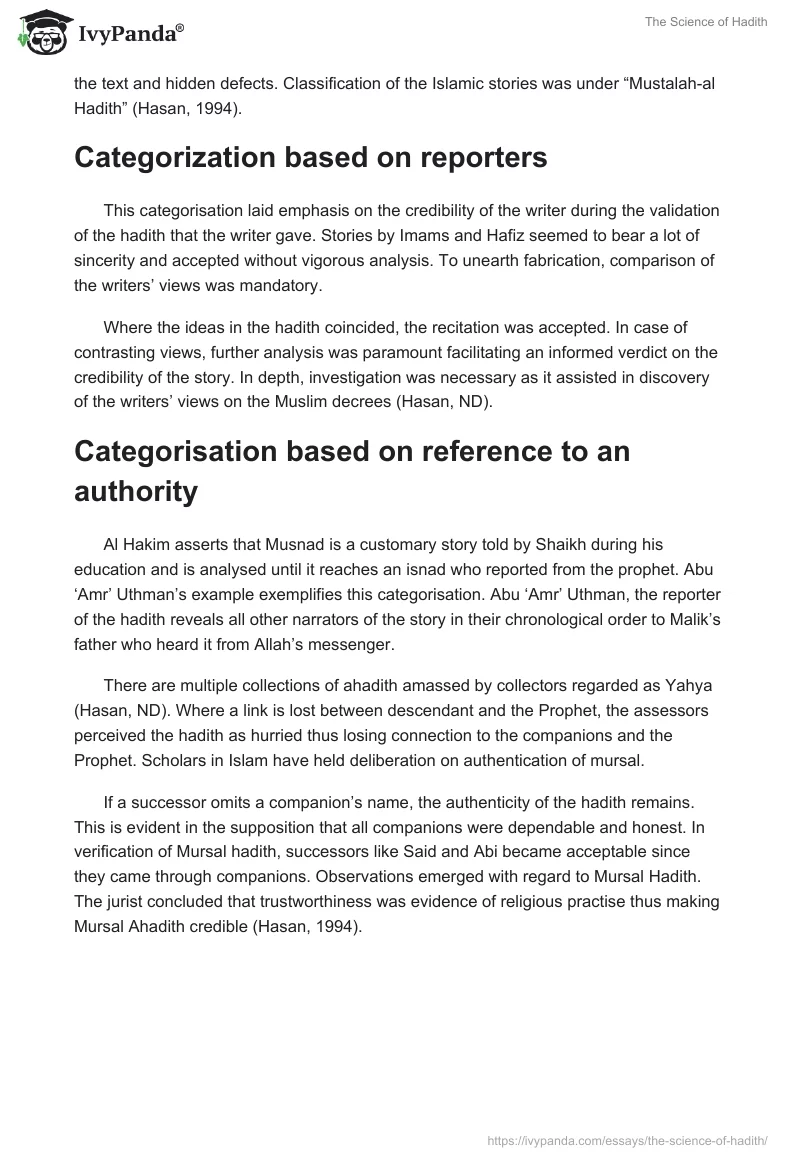Introduction
The Islamic religion began in the contemporary Saudi Arabia. Prophet Mohammed, a resident of Mecca, pioneered it. Since that time, the religion has witnessed massive growth as seen in its mammoth following in many continents. Most of the doctrines and Islamic teachings are contained in the Quran and the Sunna (Walbridge, 2010).
Allah cosseted the sacred Quran from alterations and destruction. Moreover, he gave definite individuals exceptional power to memorize and remember the teaching and principles in the Sunna. The memorized knowledge was in jeopardy as they narrated different versions. To prevent this, Allah created individuals with inconceivable intelligence and immense analytical skills.
They travelled all over the Arabia collecting narrations and distinguishing the truth from the narrations (Hasan, ND). Though various narrated ahadith varied greatly, these talented individuals were able to reconstruct the teaching and eliminate incorrect statements. Furthermore, they eliminated untrue stories by people seeking to anchor their views. The work of these individuals has made Islam a rich religion in terms of wisdom and doctrines (Hasan, 1994).
Structure of hadith
Hadith has two parts that include matn and isnad. For verification of the hadith, the writers had to be credible. A mursal was a form of hadith that cited the Prophet without acknowledging the intermediaries. During the evaluation of narratives, they looked at the writers and the various statements in the narration. The assessors deleted statements by writers who lacked credibility (Hasan, ND). They further eliminated vulgar terms irrespective of the writer.
The adoption of text in a certain hadith largely depended on the isnad , evaluation of ahadith also looked into the sounds and forgery. Various ahadith were categorised on the basis of references, authority, manner of narration, number of isnad and nature of the text and hidden defects. Classification of the Islamic stories was under “Mustalah-al Hadith” (Hasan, 1994).
Categorization based on reporters
This categorisation laid emphasis on the credibility of the writer during the validation of the hadith that the writer gave. Stories by Imams and Hafiz seemed to bear a lot of sincerity and accepted without vigorous analysis. To unearth fabrication, comparison of the writers’ views was mandatory.
Where the ideas in the hadith coincided, the recitation was accepted. In case of contrasting views, further analysis was paramount facilitating an informed verdict on the credibility of the story. In depth, investigation was necessary as it assisted in discovery of the writers’ views on the Muslim decrees (Hasan, ND).
Categorisation based on reference to an authority
Al Hakim asserts that Musnad is a customary story told by Shaikh during his education and is analysed until it reaches an isnad who reported from the prophet. Abu ‘Amr’ Uthman’s example exemplifies this categorisation. Abu ‘Amr’ Uthman, the reporter of the hadith reveals all other narrators of the story in their chronological order to Malik’s father who heard it from Allah’s messenger.
There are multiple collections of ahadith amassed by collectors regarded as Yahya (Hasan, ND). Where a link is lost between descendant and the Prophet, the assessors perceived the hadith as hurried thus losing connection to the companions and the Prophet. Scholars in Islam have held deliberation on authentication of mursal.
If a successor omits a companion’s name, the authenticity of the hadith remains. This is evident in the supposition that all companions were dependable and honest. In verification of Mursal hadith, successors like Said and Abi became acceptable since they came through companions. Observations emerged with regard to Mursal Hadith. The jurist concluded that trustworthiness was evidence of religious practise thus making Mursal Ahadith credible (Hasan, 1994).
Categorization on the basis of the proportion of writers
Many reporters made narrations of the same hadith hence disparity was unavoidable. Mutawatir was a term used to refer to generation of writers. Mutawatir were very common particularly in prayers; furthermore, companions reported this in their writings.
Some of the reporters narrated rare hadith and referenced only one individual that might have been an Imam or Shaik. Such hadith was very common among individual from one location. Certain hadith had more than two narrators. This class of stories had a common name Mashhur (Hasan, 1994).
Categorisation on basis of the way of reporting
Various narrators reported in different ways that could reveal a lot about the source of the hadith. The methods of reporting vary and include hearsay and narratives. This greatly assisted in validation of the hadith.
There are instances where the reporter covers up the identity of the Shaikh, this result in uncertainty and such a hadith is a Mudallas. During the examination, of the ahadith the evaluator unearthed many kinds of reporter based on the manner of reporting, level of disclosure about their Shaikh and their relation with the Shaikh (Hasan, ND).
Categorisation based on text
With reference to this categorisation, the hadith had to originate from credible sources creating a class of ahadith identified as shadhdh that had some popularity among the people. Presentations of ahadith by Abu Dawud and Al-Tirmidhi that are traceable to the Prophet through various companions fall under the sadhdh category. During authentication, if a hadith by a weaker narrator contradicts another, the assessors rejected the hadith (Hasan, ND).
Categorisation based on defect
To understand a faulty hadith (ma’lul), one needs to have prior knowledge on shaky (mudtarib) and reversed (maqlub) ahadith. A shaky hadith emerges when there is a contradiction as to the particulars of the shaikh, writers or the text. A muslim scholar said such are unacceptable if they go against a hadith by stronger and well founded heralds of Allah like Ibn Umar.
A reversed hadith occurs when the narrator reverses the sequence of the sentences or there is a contradiction of reporter’s name. A hadith is defective when it classified as a musnad where us it is a mursal or associated to the wrong companion (Hasan, 1994).
Categorisation based on reliability of reporter
This is the final consideration made in the classification of ahadith and established two groups namely sahih and hasan. Under this categorisation, the assessors looked at the sounds, weaknesses and fabrication. A sahih is a hadith that was devoid of weaknesses, contradictions and had a credible reporter with dependable memory (IslamKotob, ND).
A hadith under the grouping of hasan meant that it was by prominent reporters; origin is identifiable and unambiguous. Scholars made an exception to the classification under hasan by permitting several ahadith that had some flaws to this category. This grouping also identifies other ahadith that had anomalies and lacked continuity in reporters. Moreover, the narrators were ambiguous. Such fall into a class called Da’if. Maud’u was another class for ahadith that was untrue and forged (Hasan, 1994).
Conclusion
Muslims consider the consecrated Quran and Sunnah as the foundation of their doctrines (Hasan, 1994). Allah guarded the two books against destruction and corruption. The individuals that Allah created with exceptional mind to perform an in depth scrutiny of the various narrations by different reporters had a daunting task. This is evident in establishing the authenticity of a massive number of ahadith and grouping them. The above procedure assisted in the analysis of the ahadith.
The grouping of the ahadith was very detailed thus avoiding forgery and fabrication. The assessor traced the story back to the companion that heard from the Prophet. This gave them adequate reason to reject or accept ahadith. The classification was also exemplary as it further classified stories on their strength.
References
Hasan, S.(1994). Analysis on the authenticity of some commonly quoted hadith. Web.
Hasan, S. (ND). Introduction to science of hadith. Web.
Islamkotob. (ND).Introduction to science of hadith. Riyadh: Darussalam.
Walbridge, J. (2010).God and logic: The caliphate of reason. New York, NY: Cambridge University Press.


